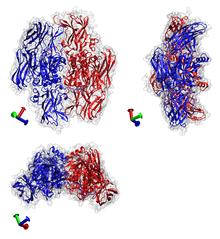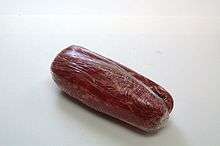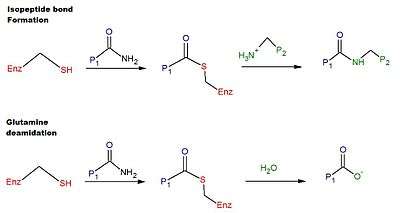Transglutaminase
| Transglutaminase | |||||||||
|---|---|---|---|---|---|---|---|---|---|
 Transglutaminase example: coagulation factor XIII from human blood. PDB code: 1EVU. | |||||||||
| Identifiers | |||||||||
| EC number | 2.3.2.13 | ||||||||
| CAS number | 80146-85-6 | ||||||||
| Databases | |||||||||
| IntEnz | IntEnz view | ||||||||
| BRENDA | BRENDA entry | ||||||||
| ExPASy | NiceZyme view | ||||||||
| KEGG | KEGG entry | ||||||||
| MetaCyc | metabolic pathway | ||||||||
| PRIAM | profile | ||||||||
| PDB structures | RCSB PDB PDBe PDBsum | ||||||||
| |||||||||
Transglutaminases are enzymes that in nature primarily catalyze the formation of an isopeptide bond between γ-carboxamide groups ( -(C=O)NH2 ) of glutamine residue side chains and the ε-amino groups ( -NH3 ) of lysine residue side chains with subsequent release of ammonia ( NH3 ). Lysine and glutamine residues must be bound to a peptide or a protein so that this cross-linking (between sperate molecules) or intermolecular (within the same molecule) reaction can happen.[1] Bonds formed by transglutaminase exhibit high resistance to proteolytic degradation (proteolysis).[2] The reaction is[1]
- Gln-(C=O)NH2 + NH2-Lys → Gln-(C=O)NH-Lys + NH3
Transglutaminases can also join a primary amine ( RNH2 ) to the side chain carboxyamide group of a protein/peptide bound glutamine residue thus forming an isopeptide bond[1]
- Gln-(C=O)NH2 + RNH2 → Gln-(C=O)NHR + NH3
These enzymes can also deamidate glutamine residues to glutamic acid residues in the presence of water[1]
- Gln-(C=O)NH2 + H2O → Gln-COOH + NH3
Transglutaminase isolated from Streptomyces mobaraensis -bacteria for example, is a calcium-independent enzyme. Mammalian transglutaminases among other transglutaminases require Ca2+ ions as a cofactor.[1]
Transglutaminases were first described in 1959.[3] The exact biochemical activity of transglutaminases was discovered in blood coagulation protein factor XIII in 1968.[4]
Physiological transglutaminases
Eight transglutaminases have been characterised.[2]
| Name | Gene | Activity | Chromosome | OMIM |
|---|---|---|---|---|
| Factor XIII (fibrin-stabilizing factor) | F13A1, F13B | coagulation | 6p25-p24 | 134570 |
| Keratinocyte transglutaminase | TGM1 | skin | 14q11.2 | 190195 |
| Tissue transglutaminase | TGM2 | ubiquitous | 20q11.2-q12 | 190196 |
| Epidermal transglutaminase | TGM3 | skin | 20q12 | 600238 |
| Prostate transglutaminase | TGM4 | prostate | 3p22-p21.33 | 600585 |
| TGM X | TGM5[5] | skin | 15q15.2 | 603805 |
| TGM Y | TGM6 | unclear | 20q11-15 | 613900 |
| TGM Z | TGM7 | testis, lung | 15q15.2 | 606776 |
Biological role
Transglutaminases form extensively cross-linked, generally insoluble protein polymers. These biological polymers are indispensable for an organism to create barriers and stable structures. Examples are blood clots (coagulation factor XIII), as well as skin and hair. The catalytic reaction is generally viewed as being irreversible, and must be closely monitored through extensive control mechanisms.[2]
A collection of the transglutaminase substrate proteins and interaction partners is accessible in the TRANSDAB database.
Role in disease
Deficiency of factor XIII (a rare genetic condition) predisposes to hemorrhage; concentrated enzyme can be used to correct the abnormality and reduce bleeding risk.[2]
Anti-transglutaminase antibodies are found in celiac disease and may play a role in the small bowel damage in response to dietary gliadin that characterises this condition.[2] In the related condition dermatitis herpetiformis, in which small bowel changes are often found and which responds to dietary exclusion of gliadin-containing wheat products, epidermal transglutaminase is the predominant autoantigen.[6]
Recent research indicates that sufferers from neurological diseases like Huntington's[7] and Parkinson's[8] may have unusually high levels of one type of transglutaminase, tissue transglutaminase. It is hypothesized that tissue transglutaminase may be involved in the formation of the protein aggregates that causes Huntington's disease, although it is most likely not required.[2][9]
Mutations in keratinocyte transglutaminase are implicated in lamellar ichthyosis.
Industrial and culinary applications

.jpg)
In commercial food processing, transglutaminase is used to bond proteins together. Examples of foods made using transglutaminase include imitation crabmeat, and fish balls. It is produced by Streptoverticillium mobaraense fermentation in commercial quantities or extracted from animal blood,[10] and is used in a variety of processes, including the production of processed meat and fish products.
Transglutaminase can be used as a binding agent to improve the texture of protein-rich foods such as surimi or ham.[11]
So-called "Meat glue" made from bovine and porcine sources was banned throughout the European Union as a food additive in 2010.[12] Transglutaminase remains allowed and is not required to be declared, as it is considered a processing aid and not an additive which remains present in the final product.
Molecular gastronomy
Transglutaminase is also used in molecular gastronomy to meld new textures with existing tastes. Besides these mainstream uses, transglutaminase has been used to create some unusual foods. British chef Heston Blumenthal is credited with the introduction of transglutaminase into modern cooking.
Wylie Dufresne, chef of New York's avant-garde restaurant wd~50, was introduced to transglutaminase by Blumenthal, and invented a "pasta" made from over 95% shrimp thanks to transglutaminase.[13]
See also
References
- 1 2 3 4 5 DeJong, GAH; Koppelman, SJ (2002). "Transglutaminase Catalyzed Reactions: Impact on Food Applications". Journal of Food Science. 67 (8): 2798–2806. doi:10.1111/j.1365-2621.2002.tb08819.x. ISSN 0022-1147.
- 1 2 3 4 5 6 Griffin M, Casadio R, Bergamini CM (2002). "Transglutaminases: nature's biological glues". Biochem J. 368 (Pt 2): 377–96. doi:10.1042/BJ20021234. PMC 1223021. PMID 12366374. Archived from the original on 20 April 2006.
- ↑ Clarke DD, Mycek MJ, Neidle A, Waelsch H (1959). "The incorporation of amines into proteins". Arch Biochem Biophys. 79: 338–354. doi:10.1016/0003-9861(59)90413-8.
- ↑ Pisano JJ, Finlayson JS, Peyton MP (1968). "[Cross-link in fibrin polymerized by factor 13: epsilon-(gamma-glutamyl)lysine.]". Science. 160 (3830): 892–3. Bibcode:1968Sci...160..892P. doi:10.1126/science.160.3830.892. PMID 4967475.
- ↑ Aeschlimann D, Koeller MK, Allen-Hoffmann BL, Mosher DF (1998). "Isolation of a cDNA encoding a novel member of the transglutaminase gene family from human keratinocytes. Detection and identification of transglutaminase gene products based on reverse transcription-polymerase chain reaction with degenerate primers". J. Biol. Chem. 273 (6): 3452–60. doi:10.1074/jbc.273.6.3452. PMID 9452468. Archived from the original on 8 March 2008.
- ↑ Sárdy M, Kárpáti S, Merkl B, Paulsson M, Smyth N (March 2002). "Epidermal transglutaminase (TGase 3) is the autoantigen of dermatitis herpetiformis". J. Exp. Med. 195 (6): 747–57. doi:10.1084/jem.20011299. PMC 2193738. PMID 11901200. Archived from the original on 2 December 2008.
- ↑ Karpuj MV, Becher MW, Steinman L (2002). "Evidence for a role for transglutaminase in Huntington's disease and the potential therapeutic implications". Neurochem. Int. 40 (1): 31–6. doi:10.1016/S0197-0186(01)00060-2. PMID 11738470.
- ↑ Vermes I, Steur EN, Jirikowski GF, Haanen C (2004). "Elevated concentration of cerebrospinal fluid tissue transglutaminase in Parkinson's disease indicating apoptosis". Mov. Disord. 19 (10): 1252–4. doi:10.1002/mds.20197. PMID 15368613.
- ↑ Lesort M, Chun W, Tucholski J, Johnson GV (2002). "Does tissue transglutaminase play a role in Huntington's disease?". Neurochem. Int. 40 (1): 37–52. doi:10.1016/S0197-0186(01)00059-6. PMID 11738471.
- ↑ Köhler, Wim (22 August 2008). "Gelijmde slavink" (in Dutch). NRC Handelsblad. Archived from the original on 20 February 2009. Retrieved 5 March 2009.
- ↑ Yokoyama K, Nio N, Kikuchi Y (2004). "Properties and applications of microbial transglutaminase". Appl. Microbiol. Biotechnol. 64 (4): 447–54. doi:10.1007/s00253-003-1539-5. PMID 14740191.
- ↑ "EU Bans 'Meat Glue' - Food Safety News". foodsafetynews.com. 24 May 2010. Archived from the original on 5 April 2018. Retrieved 6 May 2018.
- ↑ Jon, Bonné (11 February 2005). "Noodles, reinvented". MSNBC.com. Archived from the original on 12 March 2008. Retrieved 2 April 2008.
Additional sources
- Kelleher, James B. (May 11, 2012). "Industry defends ingredient critics deride as "meat glue"". Chicago Tribune. Retrieved July 20, 2012.
- U.S. Patent 5,156,956 – A transglutaminase catalyzing an acyl transfer reaction of a Γ-carboxyamide group of a glutamine residue in a peptide or protein chain in the absence of Cz2+
